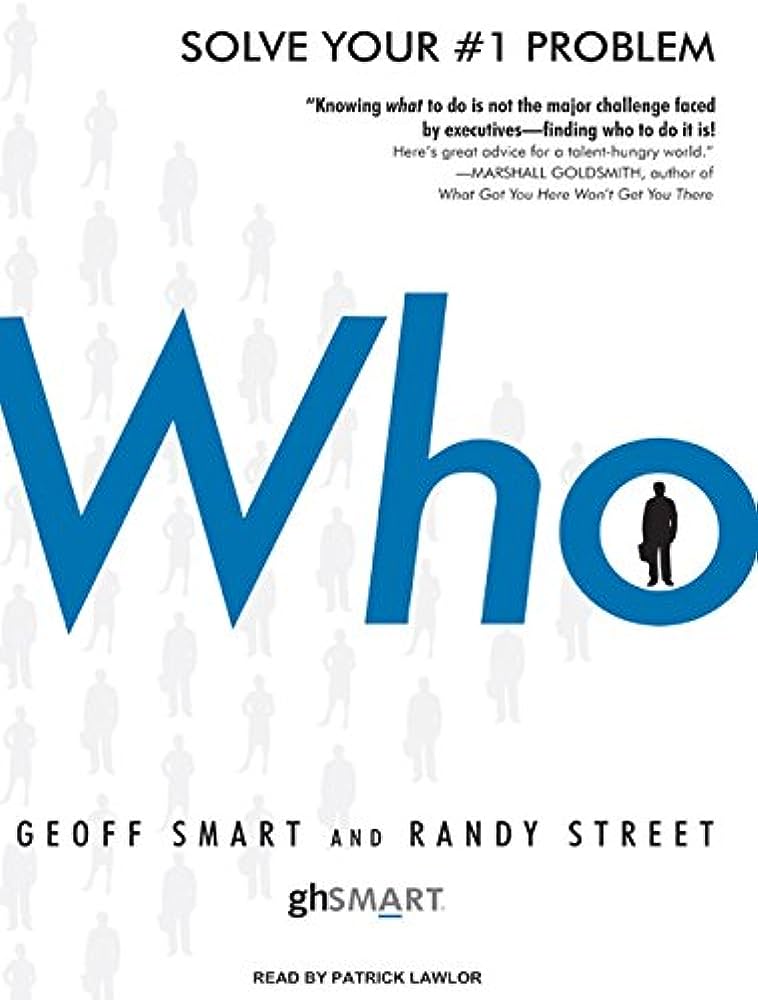The average hiring mistake costs a company $1.5 million or more a year and countless wasted hours.
Based on more than 1,300 hours of interviews with more than 20 billionaires and 300 CEOs, Who presents Smart and Street’s A Method for Hiring. In business, you are who you hire. In Who, Geoff Smart and Randy Street offer simple, easy-to-follow steps to put the right people in place for optimal success.
The most important decisions that businesspeople make are not what decisions, but who decisions.—JIM COLLINS, AUTHOR OF GOOD TO GREAT
Who refers to the people you put in place to make the what decisions. Who is running your sales force? Who is assembling your product? Who is occupying the corner office? Who is where the magic begins, or where the problems start. Ultimately, who failures infect every aspect of our professional and personal lives.
Who mistakes happen when managers:
• Are unclear about what is needed in a job
• Have a weak flow of candidates
• Do not trust their ability to pick out the right candidate from a group of similar-looking candidates
• Lose candidates they really want to join their team
“According to studies we’ve done with our clients, the average hiring mistake costs fifteen times an employee’s base salary in hard costs and productivity loss. Think about it: a single hiring blunder on a $100,000 employee can cost a company $1.5 million or more. If your business is making ten such mistakes a year, it’s pouring $15 million down the drain annually.”
What is a resume?
It is a record of a person’s career with all of the accomplishments embellished and all the failures removed.
“I hired your resume. But unfortunately, what I got was you!”
FINDING A PLAYERS
Think of an A Player as the right superstar, a talented person who can do the job you need done, while fitting in with the culture of your company. A candidate who has at least a 90 percent chance of achieving a set of outcomes that only the top 10 percent of possible candidates could achieve.
YOU ARE WHO YOU HIRE
In business, you are who you hire. Hire C Players, and you will always lose to the competition. Hire B Players, and you might do okay, but you will never break out. Hire A Players, and life gets very interesting no matter what you are pursuing.
The A Method defines a simple process for identifying and hiring A Players with a high degree of success. It helps you get the who right.
Four Steps to building A Method
Scorecard.
The scorecard is a document that describes exactly what you want a person to accomplish in a role. It is not a job description, but rather a set of outcomes and competencies that define a job done well. By defining A performance for a role, the scorecard gives you a clear picture of what the person you seek needs to be able to accomplish.
Source
Systematic sourcing before you have slots to fill ensures you have high-quality candidates waiting when you need them.
Select
Selecting talent in the A Method involves a series of structured interviews that allow you to gather the relevant facts about a person so you can rate your scorecard and make an informed hiring decision.
Sell
Once you identify people you want on your team through selection, you need to persuade them to join. Selling the right way ensures you avoid the biggest pitfalls that cause the very people you want the most to take their talents elsewhere.
Job Descriptions vs Outcomes
While typical job descriptions break down because they focus on activities, or a list of things a person will be doing (calling on customers, selling), scorecards succeed because they focus on outcomes, or what a person must get done (grow revenue from $25 million to $50 million by the end of year three).
SELECT – The four interviews for spotting A Players
“The four interviews are:
• The screening interview
• The Who Interview®
• The focused interview
• The reference interview
THE SCREENING INTERVIEW: CULLING THE LIST
The screening interview is a short, phone-based interview designed to clear out B and C Players from your roster of candidates. The goal here is to save time by eliminating people who are inappropriate for the position as quickly as possible.
- What are your career goals?
- What are you really good at professionally?
- What are you not good at or not interested in doing professionally?
- Who were your last five bosses, and how will they each rate your performance on a 1-10 scale when we talk to them?
THE WHO INTERVIEW: THE POWER OF PATTERNS FOR CHOOSING WHO
It’s a chronological walk-through of a person’s career. You begin by asking about the highs and lows of a person’s educational experience to gain insight into his or her background. Then you ask five simple questions, for each job in the past fifteen years, beginning with the earliest and working your way forward to the present day.
Who Interview Guide
What were you hired to do?
What accomplishments are you most proud of?
What were some low points during that job?
Who were the people you worked with? Specifically:
- What was your boss’s name, and how do you spell that? What was it like working with him/her? What will he/she tell me were your biggest strengths and areas for improvement?
- How would you rate the team you inherited on an A, B, C Scale? What changes did you make? Did you hire anybody? Fire anybody? How would you rate the team when you left it on an A, B, C scale?
Why did you leave that job?
THE FOCUSED INTERVIEW: GETTING TO KNOW MORE
Focused interviews allow you to gather additional, specific information about your candidate. In essence, you are turning the magnification up another notch so you can give would-be hires one last look with a finer degree of granularity.
Focused Interview Guide
- The purpose of this interview is to talk about_________________(Fill in the blank with a specific outcome or competency such as the person’s experience selling to new customers, building and leading a team, creating strategic plans, acting aggressively and persistently etc)
- What are your biggest accomplishments in this area during your career?
- What are your insights into your biggest mistakes and lessons learned in this area?
THE REFERENCE INTERVIEW: TESTING WHAT YOU LEARNED
Reference Interview Guide
- In what context did you work with the person?
- What were the person’s biggest strengths?
- What were the person’s biggest areas for improvement back then?
- How would you rate his/her overall performance in that job on a 1-10 scale? What about his or her performance causes you to give that rating?
- The person mentioned that he/she struggled with________________in that job. Can you tell me more about that?
“Avoid accepting a candidate’s reference list at face value”
Red Flags
Based on our experience, the major flags during the hiring process include:
• Candidate does not mention past failures.
• Candidate exaggerates his or her answers.
• Candidate takes credit for the work of others.
• Candidate speaks poorly of past bosses.
• Candidate cannot explain job moves.
• People most important to candidate are unsupportive of change.
• For managerial hires, candidate has never had to hire or fire anybody.
• Candidate seems more interested in compensation and benefits than in the job itself.
• Candidate tries too hard to look like an expert.
• Candidate is self-absorbed.
Five: SELL – The Top Five ways to seal the deal
The key to successfully selling your candidate to join your company is putting yourself in his or her shoes. Care about what they care about. It turns out that candidates tend to care about five things, so make sure that you address each of these five areas until you get the person to sign on the dotted line.”
The five F’s of selling, are: fit, family, freedom, fortune, and fun.
• Fit ties together the company’s vision, needs, and culture with the candidate’s goals, strengths, and values. “Here is where we are going as a company. Here is how you fit in.
• Family takes into account the broader trauma of changing jobs. “What can we do to make this change as easy as possible for your family?
• Freedom is the autonomy the candidate will have to make his or her own decisions. “I will give you ample freedom to make decisions, and I will not micromanage you.
• Fortune reflects the stability of your company and the overall financial upside. “If you accomplish your objectives, you will likely make [compensation amount] over the next five years.
• Fun describes the work environment and personal relationships the candidate will make. “We like to have a lot of fun around here. I think you will find this is a culture you will really enjoy.
“The five F’s aren’t tools for manipulating people. They are areas on which you will want to focus deep and honest attention now that you have come to the end of the recruiting process.”
All the best in your quest to get better. Don’t Settle: Live with Passion



Comments are closed.